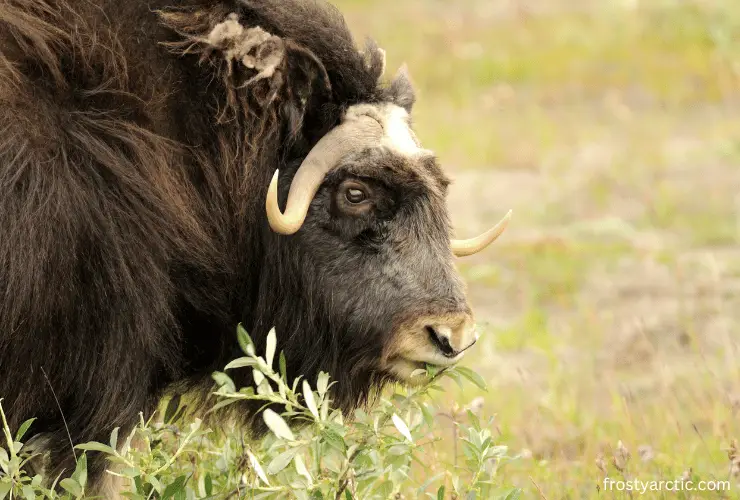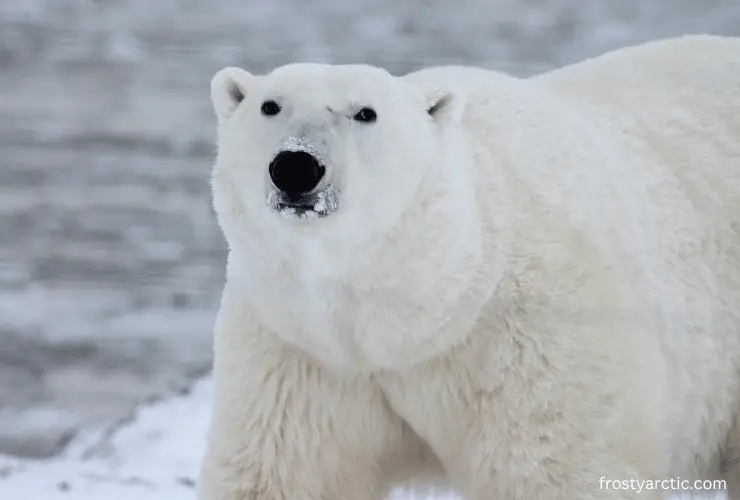Yes, polar bears, the hyper-carnivores in the Arctic Zone, eat musk ox. Although seals are one of the primary food sources for polar bears (the Arctic food chain’s kings), they also enjoy hunting calves and adult Musk Oxen. However, they prefer eating calves over adult Musk Oxen because calves are more vulnerable and, thus, easier to catch.
When it comes to talking about the land-dwelling arctic food chain, they remain on the top. Want to know how a polar bear attacks Musk Ox and gain contain over it?
Then gear up and jump to the next section, as it covers it all!
Can Polar Bears Eat Musk Ox?
Although they have their own favorite and prime food source to survive, when they feel hungry in the wild, they love to hunt musk ox (as a secondary food source), a herbivore animal that feeds primarily on grasses.
According to the US National Wildlife Federation, polar bears are known as one of the largest carnivores on Earth. They are known as the top predators in arctic areas because they eat everything, and nothing eats them.
Moreover, polar bears can eat all the internal and external organs of Muskoxen (Ovibos moschatus), along with their fat, meat, and muscles. They can, and in fact, they do eat Musk Ox.

If you want to know the nutritional value of eating musk ox or how eating musk ox can be beneficial for polar bears, you can check this link.
How Do Polar Bears Eat Musk Oxen?
Soon after the polar bear hunts a Musk Ox, it eats its muscles, meat, and tissue as they are the richest source of protein and fat.
Polar bear, being one of the largest carnivores, has a well-developed digestive system. The digestive system releases various chemicals and digestive juices to break down the fat and absorb nutrients.
The remaining undigested parts are removed as feces later on.
How Does the Digestive System of Polar Bears Differ From That of Musk Ox?
The digestive systems of Musk Oxen and polar bears are different. The former has a four-chambered stomach designed to digest and ferment hard plant fibers.

On the other hand, polar bears have a single-chambered stomach that aims to digest 97% fat and 84% protein in the food ~(Source).
- The stomach lining secretes HCl and gastric juice that helps break down the tough connective tissues in the meat of prey.
- The stomach has a single, thick-walled, muscular chamber that allows fine grinding of food.
Moreover, their unique carnivorous digestive system includes:
- A small intestine that allows quick absorption of nutrients
- A large intestine to reabsorb electrolytes and water
How Do Polar Bears Catch and Hunt Musk Oxen?
It is easier for polar bears to catch and hunt Musk Oxen in winter than in summer.
Yes! It is pretty surprising, but that is true.
Polar bears find it easier to hunt all the animals in winter. The reason is that the harsh conditions of the Arctic Tundra, including snow, make it harder for animals to run and escape.

Here is a detail of how polar bears hunt Musk Ox.
- First of all, they stalk the Musk Ox and try to approach a single Musk Ox. They, themselves white and covered with snow, blend with the snow and thus make sure that Musk Ox doesn’t detect them.
- Once polar bears approach the Ox, they attack them, mostly biting their neck or swapping them with their hard claws and paws. This is categorized as their initial attack. This causes a panic situation in musk ox.
- Then the polar bear overpowers Musk Ox and brings it to the ground.
- Later, it attacks its ribcage or skull and crushes it as the final attempt.
As a result, the musk Oxen dies, and the polar bear starts eating it.
What Other Animals Does Polar Bear Prey Upon?
Although polar bears prey upon Musk Oxen, they are known to feed on several other animals. These include:
- Seals (bearded, harp, and ringed seals)
- Bowhead whales
- Narwhal
- Carcasses
- Berries
- Seaweed
- Fishes (especially the cod fish)
- Carrion
- Walruses
- Beluga whales
- Birds
Learn how polar bears hunt by watching the below video.
However, since they are predatory animals, they neither eat plant fibers nor digest them.
Who Eats Musk Ox Other Than Polar Bears?
Apart from polar bears, there are various other predators of Musk Oxen. These include:
- Golden Eagle
- Arctic Wolves
- Brown Bears
- Wolverines
- Grizzly Bears
- Arctic Foxes
- Snowy Owls
- Humans
Why Is Musk Ox Hard to Prey Upon?
Musk Oxen are hard to prey upon not only due to their large size and rugged appearance but instead because it has undergone various additional adaptations. These include:
Strong Shaggy Coat
They have a strong, fluffy fur coat that protects them from the extreme cold and shields them against the bites, teeth, and claws of predators.
Tight-knit Group
Musk Oxen prefer to live in social groups called herds. Mostly, 10 to 20 Musk Oxen combine to form a herd. Therefore, attacking and separating one Musk Ox from the herd is a challenging row to hoe. That is why most predators avoid attacking them.
Sharp Horns
Moreover, Musk Oxen have large, curved, sharp horns. These horns help attack and deter predators, thus keeping them at bay.
Hooves
They have two hooves that help them to dig through the snow within no time, thus making it even more difficult for predators to catch them.
Can Polar Bears Eat One Musk Ox at A Time?
Mostly, Polar bears cannot eat one whole Musk Oxen at a time. A general observation is that polar bears eat nearly 40 kg at a time and, in severe cases, up to 90 kg.
On the other hand, Musk oxen mostly weigh around 200 to 400 kg, depending on the size.
So, it is not common for a polar bear to eat an entire Musk Oxen at a time. However, they can consume a baby Musk Ox in one go.
Do Polar Bears Prey on Adult Musk Oxen Or Calves?
Polar bears prey on both adult Musk Oxen and calves (small Musk Oxen). However, they prefer to hunt calves. The reason is that calves are smaller in size and comparatively weaker. So, giant polar bears can easily prey upon them, and the calf can hardly fight off in return.

However, the grown-up adult Musk Oxen are large and quite comparable to polar bears. Moreover, they are experienced at defending themselves and escaping from the eye of predators.
Therefore, hunting and preying upon them requires significant effort.
In short, calves are more vulnerable, and thus polar bears mostly prey upon them more easily than adults.
Frequently Asked Questions
Q.1 Can Musk Ox eat polar bears?
No! Musk Ox can’t eat polar bears.
The reason is that Musk Oxen are herbivores. They are adapted to eat grasses, lichens, and low-growing plants— their digestive system digest plant fibers and not animal meat.
Q.2 Are both Musk Oxen and Polar bears mammals?
Yes! Musk Oxen and Polar bears are mammals, have long hair coats, and are warm-blooded. Moreover, both are native to Arctic Tundra. However, Musk Oxen are hooved herbivores, while polar bears are predatory carnivores.
Q.3 Who eats a Polar Bear?
Polar bears are on top of the food web and therefore categorized as apex predators. Like humans, they aren’t generally eaten or preyed upon by other mammals. However, sometimes humans hunt them to obtain protein-rich meat.
Conclusion
Polar bears are carnivorous mammals. They feed on carnivores mainly and thus contribute to maintaining the food chain. They eat Musk Oxen, but only when there is a scarcity of food. Moreover, they prefer to eat calves and usually eat 40 kg in one meal.
However, polar bears are apex predators and have a few predators.



11 thoughts on “Do Polar Bears Eat Musk Oxen? [Explained]”